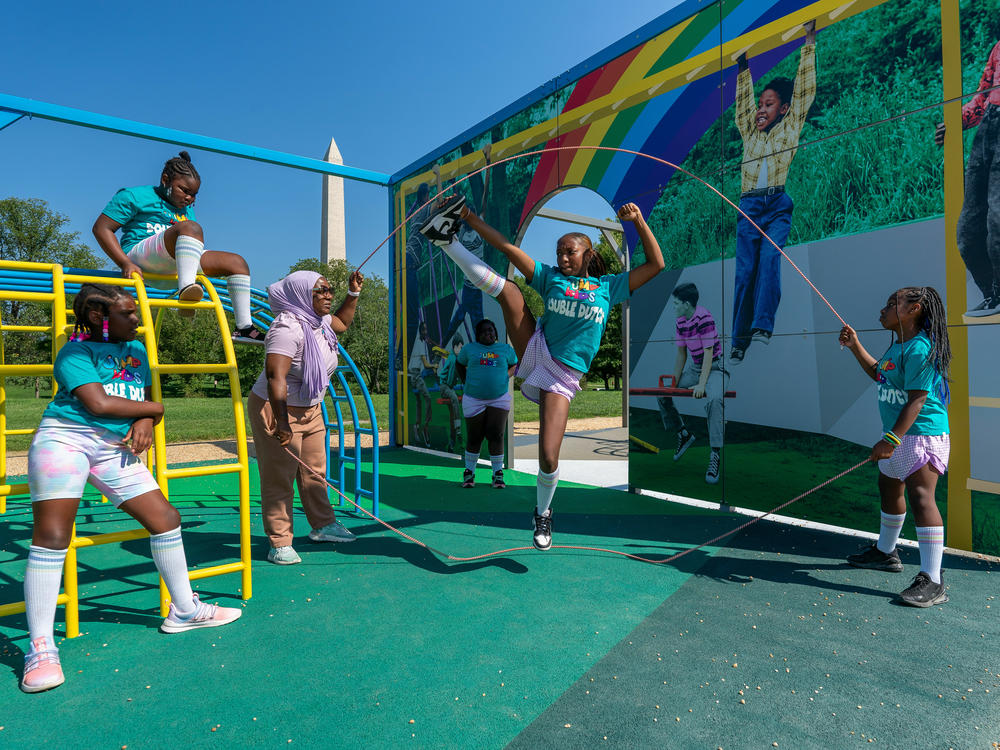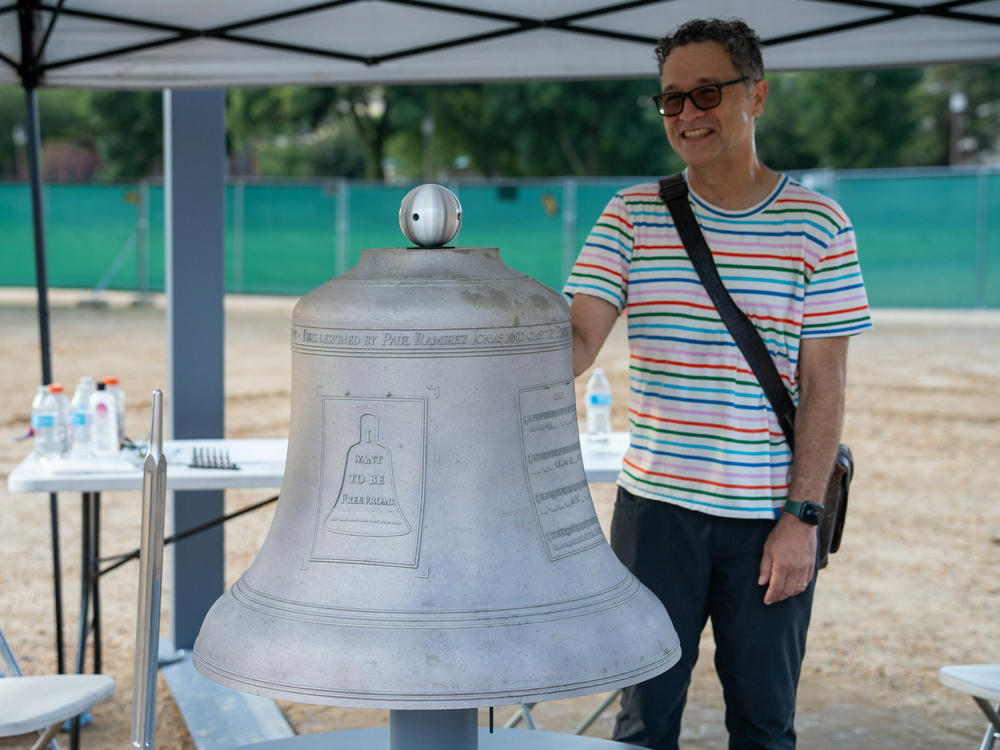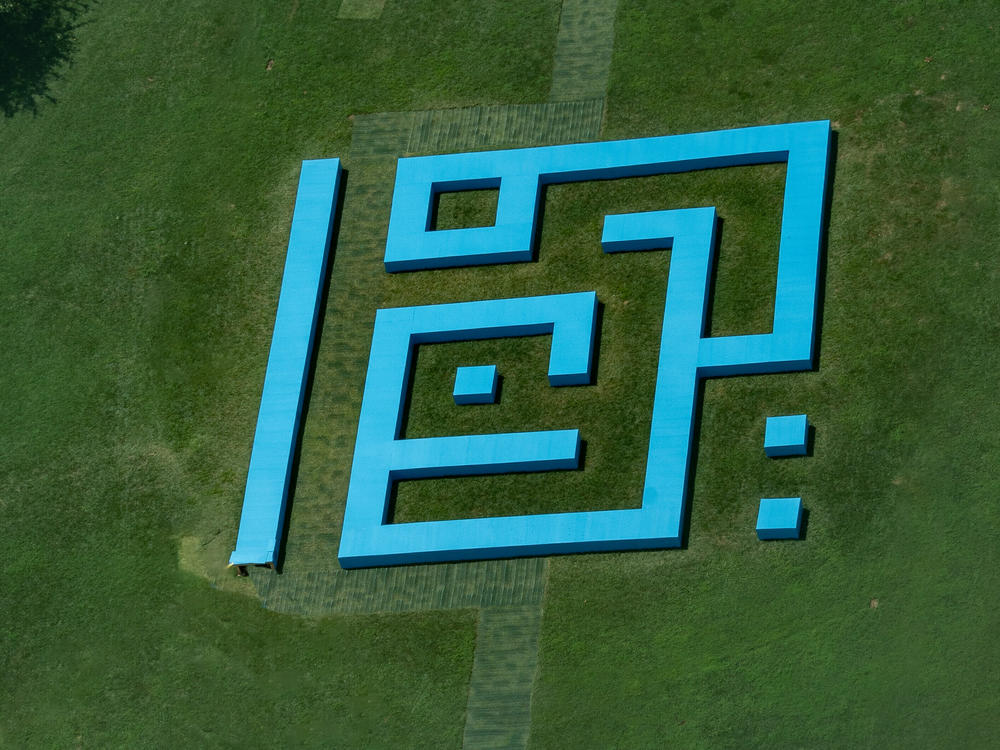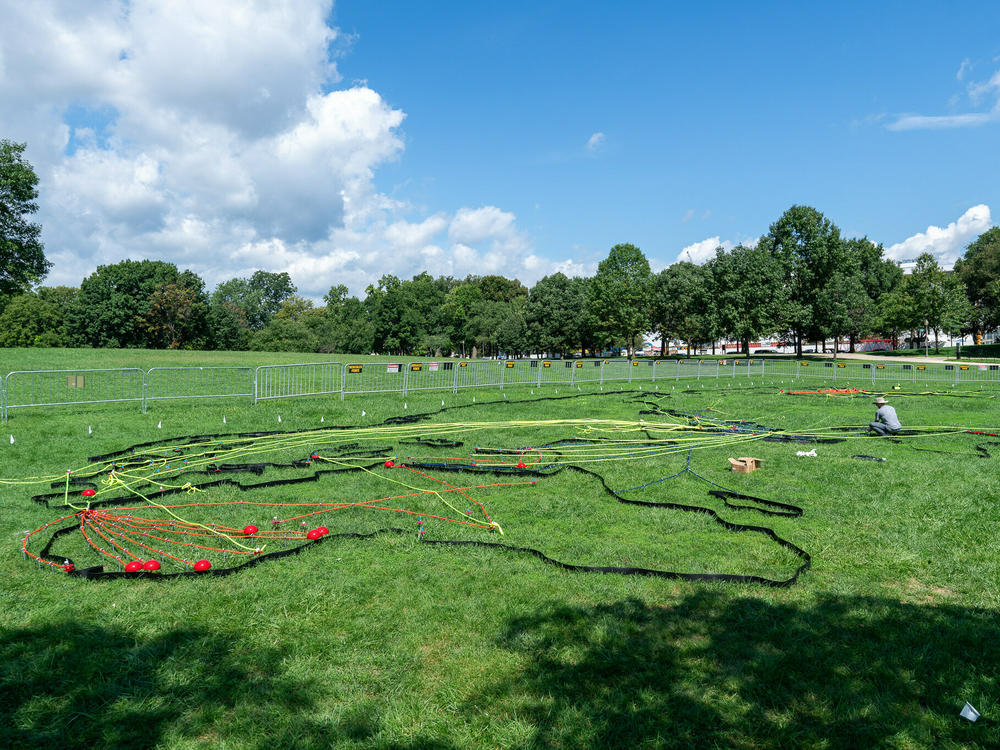Section Branding
Header Content
A groundbreaking exhibition on the National Mall shows monuments aren't set in stone
Primary Content
Kids are running all over a temporary playground in the middle of the National Mall. It's part of Beyond Granite: Pulling Together, the Mall's first-ever official outdoor show. The idea is to commemorate American stories missing from the Mall and question how history has been enshrined in stone.
These new monuments look very different from the familiar imposing white monoliths or bronze presidents in thoughtful repose. Six acclaimed artists representing a cross-section of Americans – Black, Latino, Asian and Native – from all over the country were chosen by the Philadelphia-based group Monument Lab to participate.
Artist Derrick Adams, who grew up in Baltimore, designed a working playground divided by a billboard-sized archival photograph from 1954. It shows a previously all-white park a few days after it was desegregated by court order. Joyful Black and white children are seen sliding, swinging and climbing together. Visitors are invited to use the space as it was intended.
"What does it mean to have a monument on the Mall that you can play on?" asks Salamishah Tillet. "For children to feel like it's their space, their Mall, a site of joy and happiness, is a pretty radical intervention."
Tillett co-curated this exhibition; she's also a professor at Rutgers University, where she directs the New Arts Justice initiative. This monument, she says, commemorates the fight for American children to have equal access to the right to play.
"I appreciate the fact that it's acknowledging both the difficulties of the past, the celebration of civil rights and ushering us into another present as well," she says.
Beyond Granite: Pulling Together was inspired by Marian Anderson's legendary public performance in 1939 after white supremacists banned her from singing at Constitution Hall. The Black opera star's rendition of "My Country 'Tis of Thee" on the steps of the Lincoln Memorial became a cultural touchstone.
Sculptor Paul Ramírez Jonas' bronze bell tower plays "My Country 'Tis of Thee." But the bells stop tolling right before the end. Visitors must pull a lever to play the final note.
"The piece is simply saying, America is not America without you as an active citizen," Ramírez Jonas says. "It needs you in some way."
National identity is partly defined by what we publicly mourn, observes Monument Lab Director Paul Farber. "I think about how in this country, we're bursting at the seams with grief, with loss," he says. "We don't always have a place to put it."
Putting memorials on the National Mall makes them matter, he says. Think of the AIDS quilt. Or a memorial in the show called Homegoing.
Ashon T. Crawley's maze of bright blue platforms lies in the shadow of the Washington Monument. It mourns queer musicians who directed Black church choirs, sang in their services, and died, closeted, of AIDS-related complications. Crawley, who grew up Pentecostal, honors the loss of these elders with original music playing softly from speakers. "We are your family," a choir sings. "We love and we care and sing for you."
Some visitors to the Mall may not think of these deaths as a defining national tragedy that pulls us together as Americans. This monument asks: Why not? Crawley, a professor of religion, illuminates how Black gospel music and the blues can be traced to the Muslim prayers of ancestors taken from Africa. "If you did not have that sonic practice of prayer, you wouldn't have the blues," he says. "And you wouldn't have gospel music."
From above, the monument spells out the Arabic word "amin," which means 'let this prayer be accepted,'" Crawley says. When visitors enter the maze, they join the word and the prayer by following the path.
Finding meaning, belonging and a balance between trauma and triumph is the heart of this project, says Monument Lab's Paul Farber. Artists, as artists do, are finding solutions amidst all the recent handwringing about the relevance of monuments. "We're actually looking for history to come to life," Farber says.
"You know, I think a lot of monuments commemorate dead people," notes artist Tiffany Chung. Her monument, For The Living, lies near the Vietnam Veterans Memorial. "I think it's difficult to live, and when you think about war and conflict, the consequences also fall on the shoulders of the living."
Chung was a refugee when she came from Vietnam with her family to the U.S. as a child. Her monument is a map, low on the ground, made out of thick black landscaping rubber. It shows the flight paths of migrants from Southeast Asia around the world.
"For me, instead of erecting something to really hit the sky, I want to spread it out on the earth," she continues. "Because this is us. This is where we will go back to after we leave the world. And this is beautiful. The grass will grow. The sun will wash the things away, maybe including the material that created this map. But that's the brevity of life!"
The monuments of Beyond Granite: Pulling Together aspire to heal legacies of harm. But they are not permanent. Due to various regulations, they can only be displayed until the middle of September.
Copyright 2023 NPR. To see more, visit https://www.npr.org.
Correction
An earlier version of this story misspelled the last name of Ashon T. Crawley in one sentence as Crowley.





